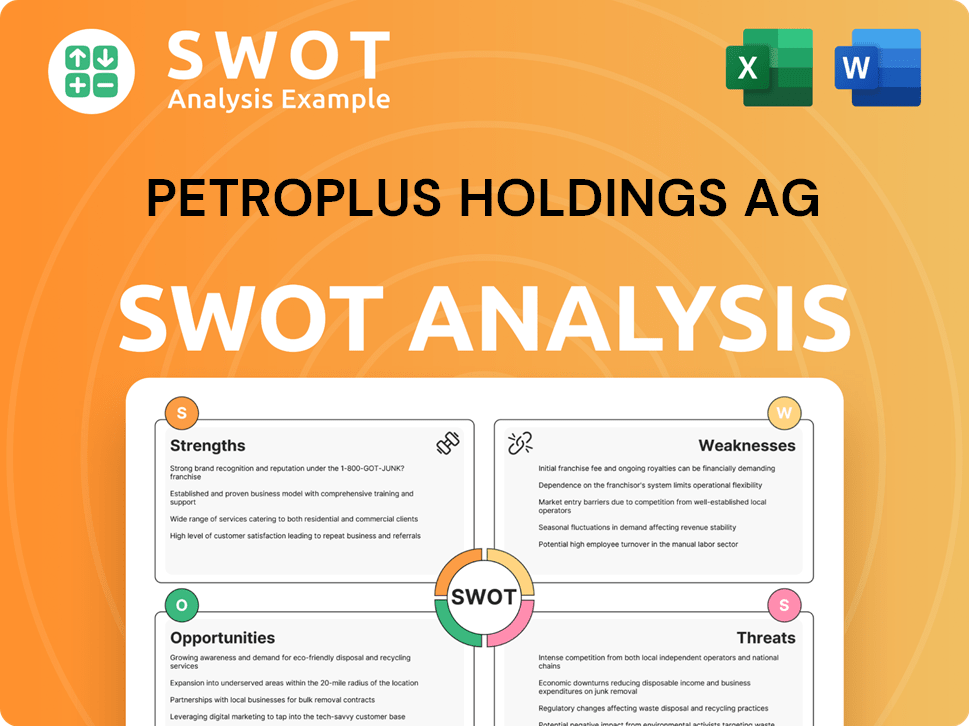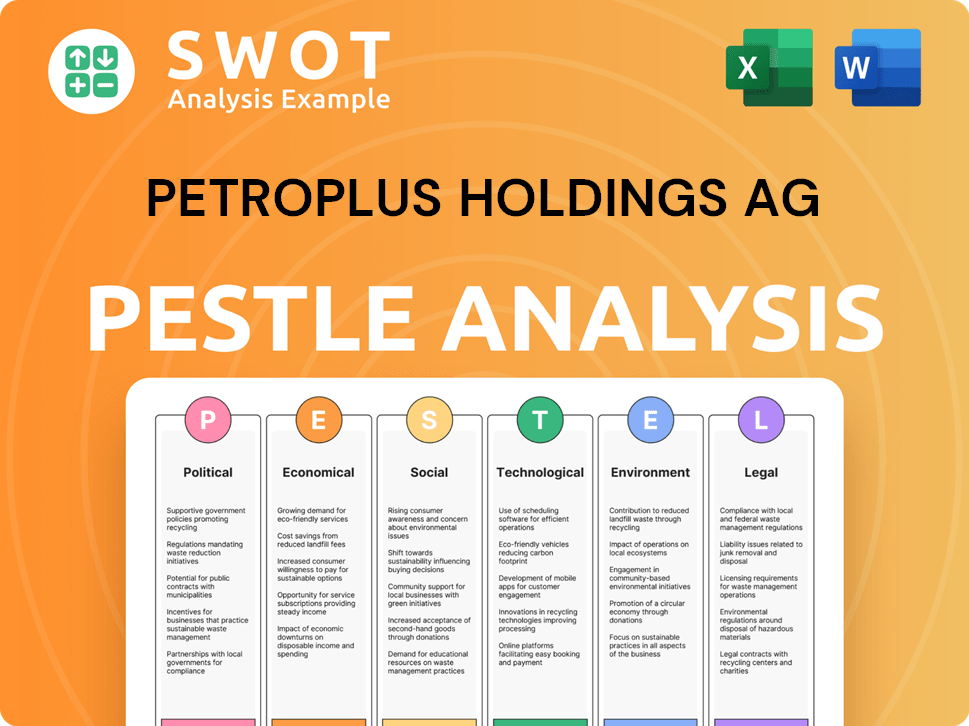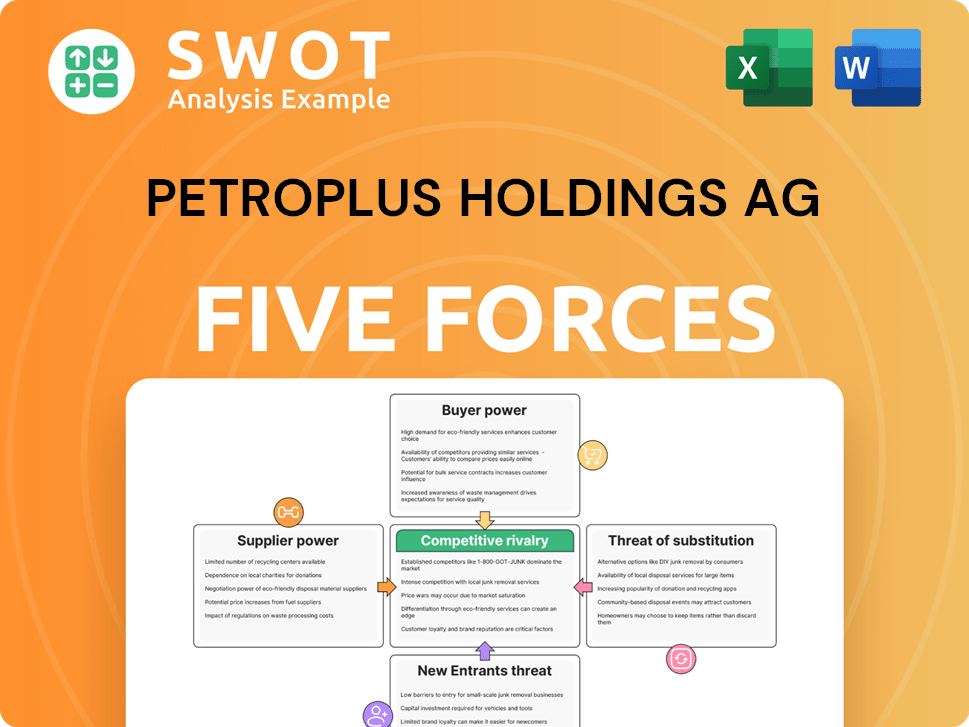Petroplus Holdings AG Bundle
What Went Wrong at Petroplus Holdings AG?
Once a titan in the European oil market, Petroplus Holdings AG's Petroplus Holdings AG SWOT Analysis reveals a story of ambition, risk, and ultimately, collapse. This Swiss company, a major player in the refining industry, controlled several oil refineries and was a key supplier of petroleum products. Its dramatic downfall offers a compelling case study in the volatile world of energy and finance.

Delving into the Petroplus history provides critical insights into the challenges faced by independent refiners. Understanding the Petroplus company's trajectory, from its early successes to its eventual bankruptcy, illuminates the impact of market forces, strategic decisions, and financial pressures on the European oil landscape. The story of Petroplus Holdings AG serves as a cautionary tale and a valuable learning opportunity for investors and business strategists alike, highlighting the complexities of the refining industry and the risks associated with high-leverage operations.
What is the Petroplus Holdings AG Founding Story?
The story of Petroplus Holdings AG, a Swiss-based company, began in 1993. Initially known as Petroplus International N.V., the company was established in the Netherlands. The primary focus was on acquiring and operating refining assets to establish a strong independent refining presence in Europe.
A key subsidiary, Petroplus Marketing AG (PMAG), played a crucial role in the group's operations. PMAG was responsible for procuring crude oil, managing its processing in the refineries, and distributing the refined products directly or through local marketing companies. The company's business model centered on refining crude oil to produce and wholesale various petroleum products.
The company's early growth strategy involved acquiring existing refining assets. The emergence of independent refiners like Petroplus was influenced by shifts in the oil and gas industry during the 1990s, as larger integrated oil companies began to divest non-core assets. For more insights into the Marketing Strategy of Petroplus Holdings AG.
Petroplus Holdings AG's formation and early years highlight its strategic focus on refining.
- Founded in 1993 as Petroplus International N.V.
- Focused on acquiring and operating refining assets in Europe.
- Petroplus Marketing AG (PMAG) was a key subsidiary.
- The business model revolved around refining crude oil.
Petroplus Holdings AG SWOT Analysis
- Complete SWOT Breakdown
- Fully Customizable
- Editable in Excel & Word
- Professional Formatting
- Investor-Ready Format

What Drove the Early Growth of Petroplus Holdings AG?
The early growth of Petroplus Holdings AG, a key player in the refining industry, was marked by an aggressive acquisition strategy. Founded in 1993, the company quickly expanded its footprint. Petroplus's listing on the Amsterdam Stock Exchange in August 1998 signaled its early ambitions.
Petroplus's growth was fueled by a series of strategic acquisitions across Europe. These acquisitions significantly increased its refining capacity. The company's expansion aimed to establish it as a leading independent refiner in Europe.
- 1997: Acquisition of the Antwerp N.V. Refinery from the Daewoo Group.
- May 2000: Purchase of the Cressier Refinery in Switzerland from Shell Switzerland.
- December 2000: Acquisition of the Teesside Refinery in Port Clarence from Phillips Petroleum Company.
- May 2006: Purchase of the BRC Antwerp Refinery for $511 million from Sovereign Holding Ltd (Bermuda).
- March 2007: Acquisition of the Ingolstadt Refinery from ExxonMobil for $425 million.
- June 2007: Purchase of the Coryton Refinery near London from BP for $1.4 billion.
- April 2008: Acquisition of the Petit Couronne and Reichstett Refineries in France from Shell for $785 million.
By 2008, Petroplus operated seven refineries across Europe. The combined throughput capacity reached approximately 864,000 barrels per day. The company's primary markets included the United Kingdom, France, Switzerland, Germany, and the Benelux countries.
In 2008, Petroplus partnered with Blackstone Group and First Reserve to pursue acquisitions of crude oil refineries in the United States, committing USD 667 million in equity. Thomas D. O'Malley, then Chairman of Petroplus, became the CEO of this new partnership, PBF Energy Co. LLC. However, Petroplus later sold its 32.62% share of PBF Energy Co. LLC for $91 million in September 2010.
The aggressive acquisition strategy led to significant debt and reliance on revolving credit facilities. Petroplus's success was heavily influenced by refining margins. The collapse in refining margins in 2008-2009 significantly impacted the company.
The company's dependence on refining margins made it sensitive to market fluctuations. The 'golden age' of refining margins between 2005 and 2008 was followed by a sharp decline. This decline in refining margins significantly contributed to the financial difficulties faced by Petroplus.
Petroplus Holdings AG PESTLE Analysis
- Covers All 6 PESTLE Categories
- No Research Needed – Save Hours of Work
- Built by Experts, Trusted by Consultants
- Instant Download, Ready to Use
- 100% Editable, Fully Customizable

What are the key Milestones in Petroplus Holdings AG history?
The Petroplus Holdings AG experienced a significant journey, marked by strategic acquisitions and operational challenges within the European oil market. This brief history of Petroplus Holdings AG highlights key milestones, innovations, and the eventual financial difficulties that led to its bankruptcy.
| Year | Milestone |
|---|---|
| August 1998 | The company was listed on the Amsterdam Stock Exchange. |
| April 2005 | Delisted from Euronext Amsterdam after being acquired by a holding company. |
| November 2006 | Public offering on the Swiss Stock Exchange. |
| 2009 | Reached a refining capacity of approximately 864,000 barrels per day across seven European refineries. |
| January 2012 | Filed for insolvency after defaulting on $1.75 billion of senior notes and convertible bonds. |
While Petroplus Holdings AG focused on acquiring refineries, it didn't necessarily introduce groundbreaking innovations in refining processes. The company's strategy was primarily focused on expanding its refining capacity through acquisitions rather than technological advancements.
Petroplus expanded its operations by acquiring existing refineries from major oil companies.
The company increased its total refining capacity through these acquisitions.
The refining industry's capital-intensive nature and market downturns presented significant challenges to Petroplus. The collapse in refining margins and the freezing of a $1 billion credit line in December 2011 severely impacted its operations, leading to its eventual bankruptcy.
The European oil market faced overcapacity and an economic slowdown, which reduced refining margins.
The freezing of a $1 billion credit line by lenders in December 2011 significantly impacted the company's ability to operate.
Several refineries, including Petit Couronne and Antwerp, were shut down due to financial difficulties.
Petroplus Holdings AG filed for insolvency in January 2012 after defaulting on its debts.
The company struggled with high working capital needs and reliance on credit facilities.
As of December 31, 2023, the company was in liquidation, with liquid assets primarily held in accounts at Zürcher Kantonalbank, and provisions of CHF 3 million were set aside for future liquidation costs.
Petroplus Holdings AG Business Model Canvas
- Complete 9-Block Business Model Canvas
- Effortlessly Communicate Your Business Strategy
- Investor-Ready BMC Format
- 100% Editable and Customizable
- Clear and Structured Layout

What is the Timeline of Key Events for Petroplus Holdings AG?
The Petroplus Holdings AG timeline is marked by rapid expansion followed by a swift decline. The company's history highlights the volatility of the refining industry and the impact of financial pressures. Here's a look at the key milestones of the Petroplus company.
| Year | Key Event |
|---|---|
| 1993 | Petroplus International N.V. was established in the Netherlands. |
| August 1998 | The company was listed on the Amsterdam Stock Exchange. |
| 1997-2008 | Petroplus pursued an aggressive acquisition strategy, acquiring several European refineries. |
| April 2005 | Delisted from Euronext Amsterdam after being acquired by a holding company. |
| November 2006 | Went public on the Swiss Stock Exchange. |
| March 2008 | Formed PBF Energy with Blackstone Group and First Reserve to pursue US refinery acquisitions. |
| September 2010 | Agreed to sell its 32.62% share in PBF Energy for $91 million to focus on European operations. |
| December 2011 | A $1 billion credit line was frozen, leading to refinery shutdown plans. |
| January 2012 | Temporary shutdowns of Petit Couronne, Antwerp, and Cressier refineries began. |
| January 24, 2012 | Petroplus Holdings AG announced filing for insolvency after defaulting on $1.75 billion in senior notes and convertible bonds. |
| January 25, 2012 | Petroplus Holdings AG and its Swiss subsidiary Petroplus Marketing AG filed for composition proceedings in Switzerland. |
| March 2012 | Petroplus Holdings AG and Petroplus Marketing AG granted ordinary composition proceedings for six months. |
| May 2012 | Definitive agreement reached for the sale of the Cressier Refinery. |
| February 2013 | Debt restructuring agreement for Petroplus Marketing AG confirmed by judge. |
| June 15, 2024 | Petroplus Refining & Marketing Limited (in Liquidation) dissolved. |
| October 22, 2024 | Circular No. 16 on the debt restructuring liquidation of Petroplus Marketing AG (PMAG) released, indicating 30.8% of estimated future dividend already paid out, with an estimated future dividend of around 0.2% remaining. |
As of October 2024, Petroplus Marketing AG is in debt restructuring liquidation. The focus is on realizing remaining assets and settling claims. Approximately 30.8% of the estimated future dividend has already been paid out.
An estimated future dividend of around 0.2% remains to be distributed. Provisions of CHF 3 million were set aside for future liquidation costs as of December 31, 2023.
The liquidation of remaining assets and claims collection for Petroplus Marketing AG will continue. Preparations for the conclusion of proceedings are underway. A further circular regarding the Report on Activities for the year is expected to be issued by Spring 2025 at the latest.
The European refining industry faces significant transformation. Diminishing refining margins, policy shifts, and global competition are creating challenges. The refining industry is also looking for new opportunities to convert into biorefineries.
Over the next decade, a reduction of 10% to 30% in refining capacity is anticipated, especially in Europe. More closures or conversions are expected by 2035.
Refineries are exploring conversion to biorefineries, e-fuel plants, or hydrogen hubs for economic viability. The strategic adjustments and closures in the European oil refining sector highlight the dynamic nature of the industry.
Petroplus Holdings AG Porter's Five Forces Analysis
- Covers All 5 Competitive Forces in Detail
- Structured for Consultants, Students, and Founders
- 100% Editable in Microsoft Word & Excel
- Instant Digital Download – Use Immediately
- Compatible with Mac & PC – Fully Unlocked

Related Blogs
- What is Competitive Landscape of Petroplus Holdings AG Company?
- What is Growth Strategy and Future Prospects of Petroplus Holdings AG Company?
- How Does Petroplus Holdings AG Company Work?
- What is Sales and Marketing Strategy of Petroplus Holdings AG Company?
- What is Brief History of Petroplus Holdings AG Company?
- Who Owns Petroplus Holdings AG Company?
- What is Customer Demographics and Target Market of Petroplus Holdings AG Company?
Disclaimer
All information, articles, and product details provided on this website are for general informational and educational purposes only. We do not claim any ownership over, nor do we intend to infringe upon, any trademarks, copyrights, logos, brand names, or other intellectual property mentioned or depicted on this site. Such intellectual property remains the property of its respective owners, and any references here are made solely for identification or informational purposes, without implying any affiliation, endorsement, or partnership.
We make no representations or warranties, express or implied, regarding the accuracy, completeness, or suitability of any content or products presented. Nothing on this website should be construed as legal, tax, investment, financial, medical, or other professional advice. In addition, no part of this site—including articles or product references—constitutes a solicitation, recommendation, endorsement, advertisement, or offer to buy or sell any securities, franchises, or other financial instruments, particularly in jurisdictions where such activity would be unlawful.
All content is of a general nature and may not address the specific circumstances of any individual or entity. It is not a substitute for professional advice or services. Any actions you take based on the information provided here are strictly at your own risk. You accept full responsibility for any decisions or outcomes arising from your use of this website and agree to release us from any liability in connection with your use of, or reliance upon, the content or products found herein.